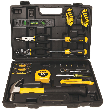Recognizing a Load-Bearing Wall
Written by Lee Wyatt (last updated March 6, 2020)
There are all kinds of reasons as to why you may want to knock down a wall or two in your home. However, if you accidentally knock out a load-bearing wall you can easily find yourself in a world of hurt. Load bearing walls are designed to hold the weight and stress of a building or home. If that support is removed, it only makes sense that the over time your home could very easily be susceptible to cracks, damage and warping. Recognizing a load-bearing wall before you begin doing your demolition can help you avoid all of these issues.
- Don't touch the exterior. A good rule of thumb is that exterior walls are going to be load bearing. The reason that this is a safe bet is that in just about every design the exterior walls are designed to hold the weight of the roof. If you do plan on doing any type of work on the exterior walls that requires you to move sections of it, be sure that you apply some additional support before you do the work.
- Foundations are a good indicator. Go down to your basement and take a look to see if you can find the foundations, any concrete footers, or girders. If you do, look up. Any wall that is located above these items should be considered load bearing.
- Look at the rafters. See if you can find any rafters in your home, and look for any walls that may be underneath them. Of those walls that are underneath, those that run perpendicular to the rafters are going to be load bearing. It is usually done this way to help spread the weight of the roof out a bit more than just on the exterior walls.
- Support beams. Take a close look at the wall you are wondering about and see if there is a support beam either above it or below it. If there is, you may be faced with a load-bearing wall, so you should proceed with caution.
- Look at the plans. If you can, take a look at the original plans for your home. These plans should have all load bearing walls clearly marked and should be easily identifiable. If you are involved directly with the construction, then ask the contractor to point out the load bearing walls to you.
Keep in mind that these are just guidelines for recognizing a load bearing wall. If you are not sure whether you have correctly identified the wall, or would like a second opinion, then you need to have a professional come and take a look at it for you.
Author Bio
Lee Wyatt
Contributor of numerous Tips.Net articles, Lee Wyatt is quickly becoming a regular "Jack of all trades." He is currently an independent contractor specializing in writing and editing. Contact him today for all of your writing and editing needs! Click here to contact. Learn more about Lee...
Cleaning Concrete
Cleaning concrete is actually something that is easier to do than what many people believe. Whether you need to clean a ...
Discover More
Getting Marble Clean
Marble is a fairly popular choice among homeowners today. Not only is it a popular choice for countertops, but also for ...
Discover More
Building a Tree House
It can pretty much be taken as a given that every child would love to have a tree house at some point in their life. ...
Discover More
More Home Improvement Tips
Hanging Pictures with Style
Everyone can hang pictures on their wall, but not everyone can do it with style. Surprisingly hanging pictures with style ...
Discover More
Fixing a Hole in a Wall
Holes in a wall are ugly, nasty, and down right embarrassing. Here is how you can fix those holes, and be proud of your ...
Discover More
Making Patches in Sheetrock
If you have holes in your sheetrock it can appear unsophisticated and unfinished. Learning to patch holes in sheetrock ...
Discover More

Comments